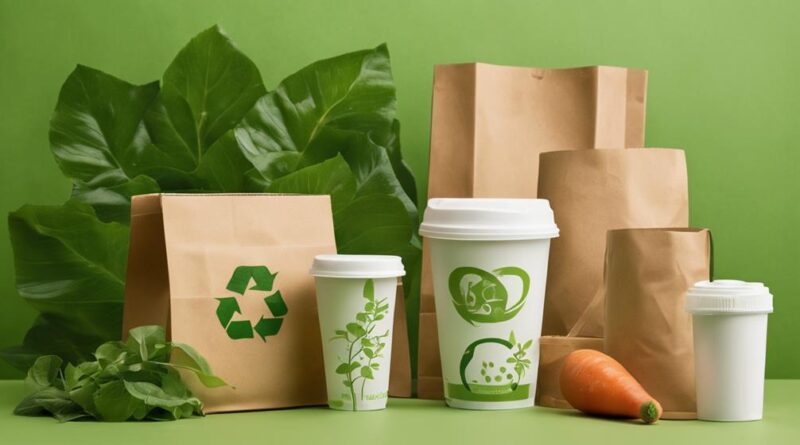Understanding Key Regulations for Eco-Friendly Food Packaging
To understand key regulations for eco-friendly food packaging, ensure materials are sourced sustainably and biodegradable. Labels should display organic certification logos and recycling instructions for transparency. Certifications from organizations like FSC verify environmental claims and overall lifecycle impact. Limit chemical use, opt for biodegradable materials, align with consumer preferences. Non-compliance may lead to fines; stay proactive for efficient enforcement. Future trends focus on innovative, biodegradable solutions to meet market demand. Following these regulations ensures compliance with sustainability standards and environmental responsibility in the food industry. Expand your knowledge on regulations for eco-friendly food packaging to stay ahead in the industry.
Definition of Organic Food Packaging
Organic food packaging refers to materials and containers that are derived from natural, renewable resources and are free from synthetic chemicals or additives. When considering organic food packaging, the benefits of sustainability, innovation, and design come to the forefront.
Sustainability is a key aspect of organic food packaging, as these materials are biodegradable and minimize environmental impact. By utilizing renewable resources, organic packaging reduces the reliance on finite fossil fuels, contributing to a more sustainable future for the planet.
In terms of innovation, organic food packaging allows for creative solutions that prioritize both functionality and environmental consciousness. Design plays a crucial role in organic packaging, as companies strive to create aesthetically pleasing containers that are also eco-friendly. Through innovative approaches to materials and technologies, organic food packaging can meet the demands of consumers while reducing waste and pollution.
Requirements for Organic Packaging Materials
Emphasizing the importance of eco-friendly practices, packaging materials used in the organic food industry must adhere to stringent requirements for sustainability and environmental impact. Sustainable sourcing is a fundamental aspect of organic packaging materials. This involves ensuring that the materials used come from renewable sources that are responsibly managed, such as certified forests or plant-based bioplastics. By prioritizing sustainable sourcing, organic packaging minimizes the depletion of natural resources and reduces the overall environmental footprint.
Environmental impact is another critical factor in the requirements for organic packaging materials. These materials must be biodegradable, compostable, or recyclable to minimize waste and pollution. Biodegradable materials break down naturally into non-toxic components, compostable materials can be turned into nutrient-rich compost, and recyclable materials can be reused in the production of new packaging. By meeting these criteria, organic packaging materials contribute to a circular economy model that aims to eliminate waste and promote sustainable practices.
Labeling Guidelines for Organic Packaging
Taking into account consumer transparency and regulatory compliance, it's essential to establish clear and informative labeling guidelines for organic packaging. When it comes to labeling organic packaging, there are several key considerations to ensure that consumers are well-informed about the sustainability and authenticity of the materials used.
- Sustainable Materials: Clearly indicate the use of sustainable materials on the packaging to highlight the eco-friendly nature of the product.
- Certified Organic: Include logos or labels that certify the organic nature of the packaging materials, providing consumers with a quick way to identify organic products.
- Consumer Education: Provide information about the benefits of using organic packaging materials to educate consumers on the importance of sustainable choices.
- Recycling Instructions: Include clear recycling instructions on the packaging to encourage proper disposal and promote a circular economy.
Certifications for Organic Food Packaging
To ensure the credibility and authenticity of eco-friendly food packaging, understanding the various certifications available for organic packaging materials is crucial. Sustainability certifications play a significant role in verifying the environmental claims of packaging materials. These certifications assess the entire lifecycle of the packaging, from sourcing raw materials to disposal, ensuring that the packaging meets specific environmental standards. One key aspect of these certifications is the environmental impact assessment, which evaluates factors like energy consumption, greenhouse gas emissions, and waste generation.
When seeking certifications for organic food packaging, look for well-known organizations such as the Forest Stewardship Council (FSC) or the Sustainable Forestry Initiative (SFI). These organizations provide certifications for packaging materials sourced from responsibly managed forests, ensuring that the production process has minimal negative impacts on the environment. Additionally, certifications like the Cradle to Cradle CertifiedTM program evaluate packaging materials based on criteria such as material health, material reutilization, renewable energy use, water stewardship, and social fairness.
Restrictions on Organic Packaging Practices
An essential aspect of maintaining the integrity of eco-friendly food packaging lies in adhering to specific restrictions on organic packaging practices. When considering organic packaging, there are several crucial restrictions to keep in mind to ensure sustainability impact and align with consumer preferences:
- Biodegradability: Organic packaging materials must be biodegradable to reduce environmental impact and promote sustainability.
- Chemical Restrictions: Limiting the use of chemicals in the production of organic packaging is essential to avoid harmful substances entering the ecosystem.
- Recyclability: Organic packaging should be easily recyclable to encourage consumers to participate in recycling programs and reduce waste.
- Renewable Resources: Opting for materials sourced from renewable resources helps maintain ecological balance and reduces the carbon footprint of the packaging.
Compliance With Organic Packaging Standards
When moving from restrictions on organic packaging practices to compliance with organic packaging standards, ensuring strict adherence to eco-friendly criteria becomes paramount for sustainable food packaging solutions. Sustainable practices in organic packaging involve using materials that have minimal environmental impact throughout their lifecycle. This includes sourcing materials from renewable resources, utilizing energy-efficient manufacturing processes, and ensuring biodegradability or recyclability.
Compliance with organic packaging standards necessitates a thorough understanding of the environmental impact of different packaging materials. For instance, opting for compostable packaging made from plant-based materials can significantly reduce the carbon footprint compared to traditional plastic packaging. It's essential to assess the entire supply chain to ensure that each component meets the required organic standards and contributes to sustainable practices.
When evaluating compliance with organic packaging standards, consider the end-of-life scenario for the packaging. Biodegradable packaging may break down into organic matter, contributing positively to the environment. However, if not disposed of correctly, even organic packaging can have adverse effects. Therefore, educating consumers on proper disposal methods is crucial for ensuring the effectiveness of organic packaging in reducing environmental impact.
Monitoring and Enforcement of Regulations

Monitoring and enforcing regulations for eco-friendly food packaging involves conducting regular audits and inspections to ensure compliance with sustainability standards and environmental goals. To effectively enforce these regulations, several enforcement measures are typically implemented:
- Random Inspections: Regulatory bodies conduct surprise inspections at packaging facilities to check for compliance with eco-friendly standards. These surprise visits keep companies on their toes, ensuring continuous adherence to regulations.
- Document Reviews: Authorities review documentation related to the sourcing of packaging materials, manufacturing processes, and disposal methods. This helps in verifying that all practices align with the current sustainability regulations.
- Penalties and Fines: Non-compliance with eco-friendly packaging regulations can lead to significant fines or penalties. This serves as a deterrent to companies that may consider cutting corners to save costs.
- Public Reporting: Making compliance data public encourages transparency and accountability. Companies are more likely to follow regulations when aware that their adherence is being monitored and reported.
Regulatory updates play a crucial role in monitoring and enforcement efforts. As sustainability practices evolve, regulations must adapt to reflect the latest environmental standards. Keeping abreast of these updates is essential for both regulatory bodies and food packaging companies to ensure that packaging materials remain eco-friendly and in line with current environmental goals. Regular communication between regulators and industry stakeholders is vital to address any emerging challenges effectively. By staying proactive and responsive to regulatory changes, the monitoring and enforcement of eco-friendly food packaging regulations can be carried out efficiently.
Future Trends in Organic Packaging Regulations
Future trends in organic packaging regulations are increasingly emphasizing the use of innovative materials and technologies to enhance sustainability practices in the food packaging industry. Sustainable innovation is at the forefront of these developments, driven by market demand for eco-friendly solutions. As consumer awareness grows regarding the environmental impact of packaging, regulatory bodies are pushing for stricter guidelines to promote the use of organic materials and reduce waste.
One key aspect of future regulations is the promotion of biodegradable and compostable packaging materials. Manufacturers are exploring plant-based plastics, such as polylactic acid (PLA) and bio-based polyethylene, to create packaging that breaks down naturally, reducing the burden on landfills. Additionally, advancements in technology are enabling the development of smart packaging solutions that can extend the shelf life of products, reducing food waste and the need for preservatives.
To meet the evolving regulatory landscape, companies are investing in research and development to stay ahead of the curve. This proactive approach not only ensures compliance with current regulations but also prepares businesses for future requirements. By aligning with sustainable innovation trends and responding to market demand for organic packaging, companies can enhance their brand reputation and contribute to a more environmentally friendly food packaging industry.
Conclusion
As you navigate the world of eco-friendly food packaging, it's crucial to understand the key regulations that govern this industry.
By adhering to requirements for organic packaging materials, labeling guidelines, certifications, and restrictions, you can ensure compliance with standards and contribute to a more sustainable future.
Stay informed about the latest trends in organic packaging regulations to stay ahead of the curve and make a positive impact on the environment.
